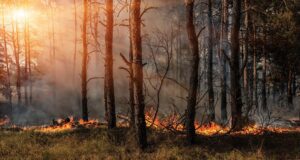 In the searing aftermath of bushfires, Victoria has forged not just scars on its landscape but a legacy of learning. From the ferocity of Black Thursday in 1851 to the horror of Black Summer beginning in 2019, bushfires have been central to Victoria’s settler history shaping its forests, institutions, communities, and consciousness.
In the searing aftermath of bushfires, Victoria has forged not just scars on its landscape but a legacy of learning. From the ferocity of Black Thursday in 1851 to the horror of Black Summer beginning in 2019, bushfires have been central to Victoria’s settler history shaping its forests, institutions, communities, and consciousness.
For nearly two centuries, the state’s relationship with fire has transformed from fragmented firefighting efforts to one of the most integrated and forward-looking emergency management systems in the world.
The Slow Awakening: 19th Century Firefighting
In the 19th and early 20th centuries, bushfires were seen as inevitable acts of nature. Local landholders and loosely organized brigades bore the burden with limited coordination or governmental oversight. Even devastating fires like Red Tuesday in 1898 triggered only modest responses chiefly centered around forest and timber management rather than community safety.
Royal commissions were rare and narrow in scope. The 1901 inquiry focused more on forest regulation than prevention or coordination. For decades, Victoria lacked fire-specific legislation, and systemic reform remained elusive.
Black Friday 1939: A Turning Point
It took the catastrophic Black Friday fires of 1939 which killed 71 people and razed entire towns for a meaningful reckoning. The Stretton Royal Commission that followed marked a watershed moment: it redefined how fire risk was understood and how institutions should respond.
Its legacy included the establishment of the Country Fire Authority (CFA) in 1945 a foundational shift toward statewide governance of bushfire management.
Reform Through Tragedy: Learning from Fire
The decades that followed saw a distinct pattern: major fire events triggered public scrutiny, leading to commissions, coronial inquiries, and sweeping reforms. Each disaster became a learning moment:
The 1983 Ash Wednesday fires spotlighted the need for better inter-agency coordination.
The 2009 Black Saturday fires the deadliest in Australia’s history sparked the most comprehensive emergency management review in the nation.
The Royal Commission’s 67 recommendations from Black Saturday reshaped how Victoria communicates risk, manages evacuations, and coordinates agencies.
What emerges is a compelling story of institutional learning. Each blaze didn’t just leave destruction it left blueprints for better, smarter, more inclusive fire management.
From Reactive to Proactive: A System Reimagined
Gone are the days when Victoria’s approach to fire was purely reactive. Today, bushfire management is year-round and deeply collaborative. It includes:
- Risk reduction strategies
- Community-led preparedness planning
- Early warning systems
- Inter-agency coordination drills
Hybrid governance models now bring together public sector agencies, local councils, community organizations, businesses, and volunteers. These collaborative approaches acknowledge that no single entity can tackle the growing complexity of fire risk alone.
Preparedness Is for Everyone
One of the most radical shifts has been in whose voices matter. Historically underserved communities including multicultural groups, LGBTIQ+ people, youth, and people with disabilities are now recognized in planning and recovery efforts.
Importantly, First Nations knowledge is gaining overdue respect. Traditional burning practices are being revived as ecologically sustainable ways to manage fuel loads and reduce fire intensity wisdom long sidelined by Western approaches.
The Power of Public Inquiries
Since 1939, public inquiries have become a mechanism for systemic change in Victoria. These aren’t just about assigning blame they identify root causes and recommend wide-reaching reforms that are typically implemented with seriousness.
From national warning systems to operational frameworks, these inquiries have built a culture of institutional accountability, resilience, and transparency.
A Future Still on Fire
Despite remarkable progress, Victoria’s fire challenges are far from over. Climate change is stretching fire seasons, intensifying heatwaves, and challenging old models. Urban sprawl into fire-prone zones increases exposure. Changes in volunteerism and shrinking rural populations test traditional fire service models.
To adapt, the state is investing in data-driven risk mapping, regional partnerships, satellite monitoring, and inclusive planning strategies that reach even the most marginalized.
A Global Blueprint for Resilience
Victoria’s long bushfire history is not just a cautionary tale it’s a global case study in adaptive governance. It shows how tragedy can be a catalyst for profound institutional reform.
It reveals how resilience is built not through top-down mandates alone, but through community inclusion, cultural recognition, and cross-sector collaboration.
For countries worldwide grappling with climate-fueled disasters, Victoria offers a rare commodity: hope backed by hard-won wisdom.
Its journey proves that from the ashes of disaster, stronger, fairer, and more responsive systems can rise.
